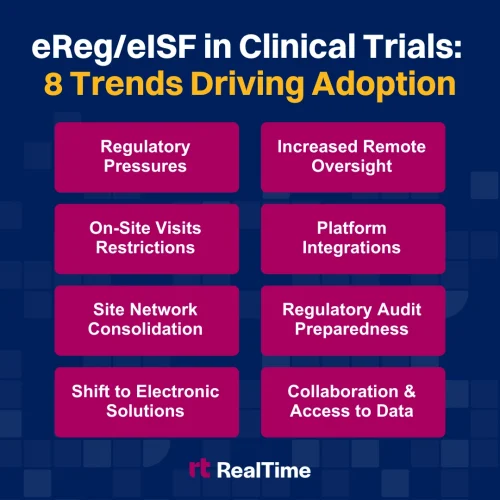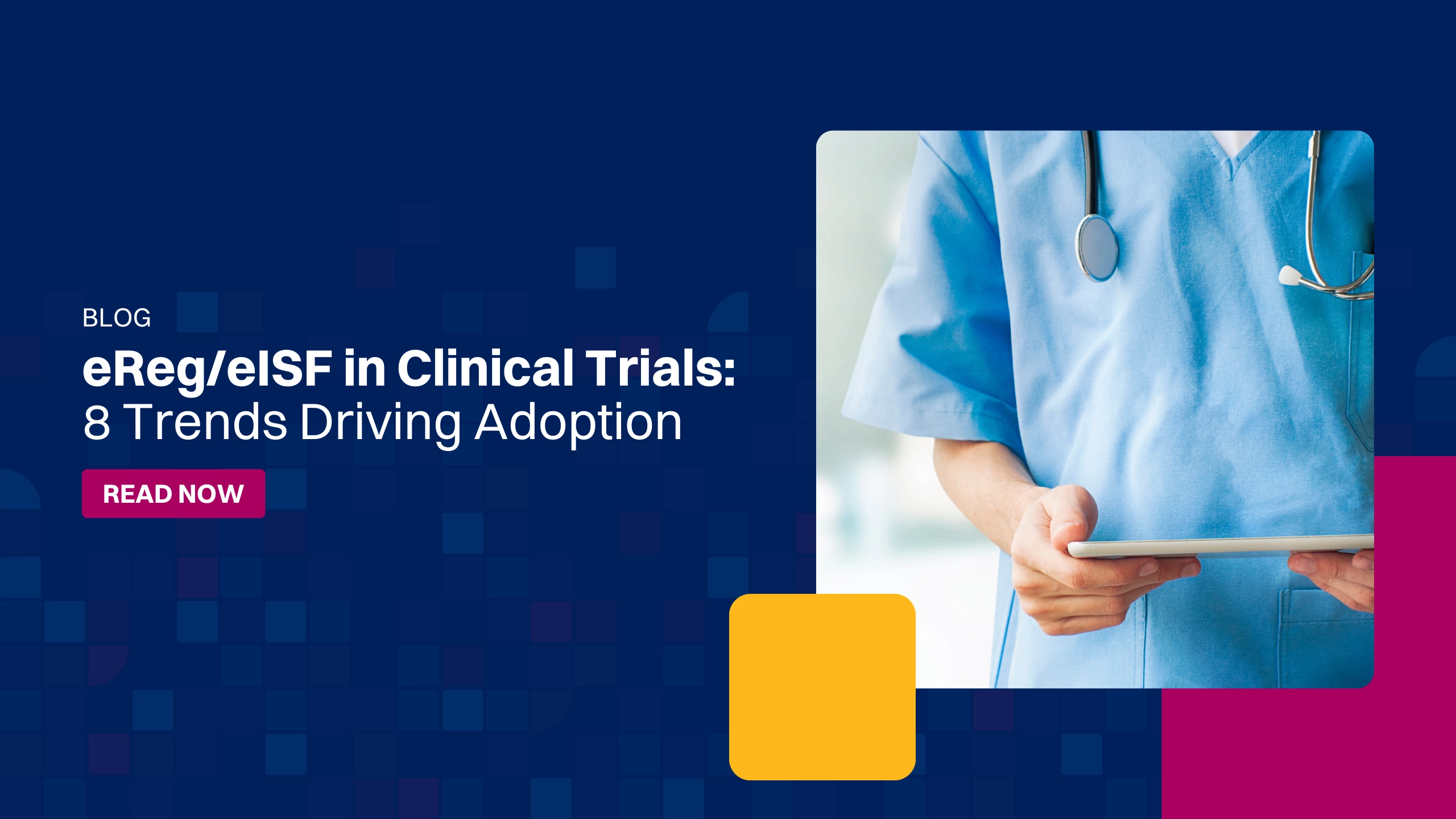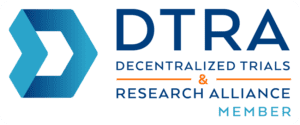In our blog, “What is eRegulatory in Clinical Trials,” we explored four key trends fueling the adoption of eReg/eISF across Academic Medical Centers (AMCs), sites, site networks, and sponsors. In this follow-up, we dive deeper, expanding on four additional trends driving eReg/eISF in clinical trials.
The transition from paper-based systems or disconnected platforms to integrated eClinical solutions delivers greater efficiency in how clinical trial sites, AMCs, sponsors, and CROs manage essential regulatory documentation. eReg/eISF refers to the electronic management of regulatory documents and workflows in clinical research, and its rising importance is being driven by several emerging trends that we’ll discuss here. Before we explore these new trends, let’s recap the first four trends covered in “What is eRegulatory in Clinical Trials.”
1. Regulatory Pressures Driving eReg/eISF Adoption
The adoption of eReg/eISF systems in clinical trials is being driven by several key trends. Increasing regulatory scrutiny and the growing complexity of compliance requirements, such as FDA 21 CFR Part 11 and ICH GCP, are pushing organizations to adopt more systematic and reliable solutions for managing regulatory documentation. In fact, in one report by Grand View Research, the global eClinical solutions market which includes eReg/eISF—is projected to grow at a compound annual growth rate (CAGR) of 14.1% from 2024 to 2030. This growth is driven by the stringent regulatory landscape for clinical trials and an intensified focus on safety monitoring. Furthermore, the growing volume and complexity of data in clinical trials is creating a pressing need for platforms that can manage large amounts of information while maintaining data integrity and accessibility. For example, according to a report published by the National Institutes of Health a typical 12-month trial with 2,000 participants can generate as many as 3 million data points, creating approximately 10 million opportunities for error, as data often gets handled multiple times—during clinic visits, double data entry, and data cleaning processes. Even with an optimal error rate of 1 in 1,000, this would still result in around 10,000 errors.1 Unfortunately, actual error rates tend to be much higher, which highlights the importance of adopting eClinical solutions capable of managing these volumes while ensuring regulatory compliance.
2. Restrictions Limiting On-site Visits
Additionally, some sites are restricting on-site monitor access due to cost, inconvenience, or local site policies. eReg/eISF platforms address these challenges by offering remote access to critical documentation. This safeguards regulatory compliance while accommodating site-specific needs.
3. Impact of Site Network Consolidation on eReg/eISF Adoption
Moreover, the trend towards site network consolidation is playing a significant role in the shift to eReg/eISF. As smaller sites join larger networks or merge with other entities, there is an increased need for standardized and centralized document management processes across multiple locations. eReg/eISF solutions enable these organizations to maintain consistency, compliance, and oversight, even as they scale and integrate new sites.
4. Impact of Site Network Consolidation on eReg/eISF Adoption
Moreover, the trend towards site network consolidation is playing a significant role in the shift to eReg/eISF. As smaller sites join larger networks or merge with other entities, there is an increased need for standardized and centralized document management processes across multiple locations. eReg/eISF solutions enable these organizations to maintain consistency, compliance, and oversight, even as they scale and integrate new sites.
After revisiting the initial four trends, let’s unpack four additional key factors driving the widespread adoption of eReg/eISF in clinical trials.
Here are four more trends driving the adoption of eReg/eISF in clinical trials:
5. Increased Remote Oversight
The necessity for remote monitoring and oversight became evident during the pandemic as travel restrictions and health concerns limited traditional site visits. Regulatory agencies like the FDA and EMA adapted quickly, issuing guidance such as the FDA Guidance on Conduct of Clinical Trials of Medical Products during COVID-19 Pandemic and the EMA’s Guidance on the Management of Clinical Trials during the COVID-19 (Coronavirus) Pandemic. These guidelines emphasized the importance of remote monitoring and virtual trial visits to ensure the continuity of clinical trials pivot necessitated electronic platforms that could handle secure remote access to regulatory documents while ensuring strict adherence to regulatory guidelines such as 21 CFR Part 11 and ICH GCP.
How does eReg/eISF increase remote oversight?
- eReg/eISF allows sponsors and CROs to access regulatory binders, site documentation, and essential study records remotely, eliminating the need to be physically present for review.
- Sponsors and CROs can track the status of regulatory documents in real-time, ensuring they are up-to-date and compliant without having to wait for on-site checks.
- With remote access, issues such as missing or incomplete documentation can be identified and addressed more quickly, speeding up the overall study process and reducing delays.
- By enabling remote document review and oversight, eReg/eISF can significantly reduce the need for frequent on-site monitoring visits. This cuts down on travel costs and time spent coordinating in-person interactions.
- The ability to review and approve documents remotely enables faster regulatory approvals and accelerates study start-up times, ultimately shortening trial timelines.
6. Platform Integrations
Sponsors and CROs are increasingly prioritizing the integration of eReg/eISF systems with other critical software like Clinical Trial Management Systems (CTMS). This integration facilitates seamless data transfers that eliminates duplicate work and inefficient workflows. Consequently, there is a growing demand for eReg/eISF solution that integrate seamlessly with other systems and align with existing site workflows.
What are the benefits of an eReg/eISF integration?
For example, integrating eReg/eISF with CTMS reduces compliance risks and improves audit readiness by minimizing manual data entry and document retrieval efforts. Additionally, the integration offers several other powerful capabilities:
- Key documents, including training certificates, regulatory approvals, and investigator credentials, are immediately available for each new trial, speeding up study start-up.
- The integration enables efficient data exchange across platforms, minimizing the chance of errors and ensuring that regulatory requirements are met consistently.
7. Regulatory Audit Preparedness
To comply with good Clinical Practice Guidelines, as well as scrutiny from regulatory bodies such as the FDA, EMA and other global regulatory agencies, it is important to maintain accurate, complete and accessible regulatory documentation.
This where eReg/eISF shines. With real-time access to documentation and streamlined workflows, sites, AMCs, and sponsors are better prepared for audits. eReg/eISF are centralized platforms where all regulatory documents, including site binders, informed consent forms and investigational products documentation are stored and managed. This level of organization minimizes the risk of findings that could delay studies or lead to non-compliance penalties.
Here are a few key features of eReg/eISF that support audit preparedness:
- Tracks document changes and generate audit trails that safeguard that documentation remains compliant with regulatory requirements
- Provides real-time access to documentation and organizes workflows
- Facilitates the signing of documents electronically, thus automating the approval processes
- Additionally, eReg and eISF systems help to eliminate error-prone paper-based documentation by automating repetitive tasks while securely storing and providing easy access to all regulatory documentation
Altogether, these capabilities improve accountability, transparency, and provide organizations with a stronger compliance framework.
8. Increased Collaboration and Real-Time Access to Data
Clinical trials involve multiple stakeholders, including sponsors, CROs, study coordinators, investigators, and regulatory authorities. Effective collaboration and coordination among these parties is essential to the success of any trial. However, traditional regulatory processes are labor-intensive, prone to errors, and require significant time and resources to maintain. These processes also often involve fragmented communication, delayed document sharing, and limited visibility into the status of critical documents. eReg/eISF addresses these challenges by providing a centralized digital platform where all stakeholders can access and collaborate on regulatory documentation in real time.
Here’s how eReg/eISF drives improved collaboration and data access:
- Significantly reduce delays and bottlenecks by facilitating efficient tracking of document progress
- Ensures that critical tasks are completed on time
- Enables document sharing and task assignments
- Role-based access controls, stakeholders can securely view, edit, or approve documents based on their specific responsibilities
- Powerful reporting tools that provide insights into study metrics
These capabilities have been proven to improve coordination and transparency across study teams. Altogether, with eReg/eISF, organizations can make informed decisions and proactively address any issues before they become a compliance headache for your team.
Wrap Up
The move towards more integrated and remote-friendly trial environments is set to redefine the norms of clinical research. These trends collectively highlight the growing importance of eReg and eISF in clinical trials. By leveraging eReg/eISF, sites, AMCs and sponsors/CROs can streamline regulatory processes, eliminate inefficiencies, and reduce administrative burdens. Purpose-built eClinical solutions like eReg/eISF allow for automated workflows, faster document routing and approval, and real-time collaboration among study teams, regardless of geographic location. Moreover, the reduction in paper usage and storage costs, coupled with faster document processing times, results in significant cost savings.
In summary, the adoption of eReg/eISF in clinical trials is being driven by several key trends. From improving regulatory compliance and audit readiness, to efficiency, cost reduction, better collaboration, and supporting the rise of decentralized trials, these factors are all playing significant roles in this shift. For organizations looking to stay competitive, embracing eReg/eISF is essential.

Read More: What is eRegulatory in Clinical Trials
Read More: What is in an Investigator’s Site File
1 Davis JR, Nolan VP, Woodcock J, et al., editors. (1999). Assuring Data Quality and Validity in Clinical Trials for Regulatory Decision Making: Workshop Report. Washington (DC): National Academies Press (US). Retrieved from https://www.ncbi.nlm.nih.gov/books/NBK224576/.






